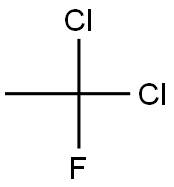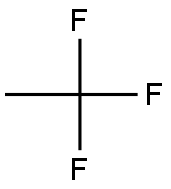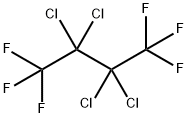1,1-Dichloro-2,2,2-trifluoroethane
Synonym(s):2,2-Dichloro-1,1,1-trifluoroethane solution
- CAS NO.:306-83-2
- Empirical Formula: C2HCl2F3
- Molecular Weight: 152.93
- MDL number: MFCD00042132
- EINECS: 206-190-3
- SAFETY DATA SHEET (SDS)
- Update Date: 2024-12-18 14:15:30

What is 1,1-Dichloro-2,2,2-trifluoroethane?
Chemical properties
1,1-Dichloro-2,2,2-trifluoroethane has a light ethereal odor with poor warning properties.
The Uses of 1,1-Dichloro-2,2,2-trifluoroethane
HCFC 123 is an interim replacement for the CFCs and is scheduled for a production phase-out during the 2020s. Its main application is as a substitute for CFC 11 in centrifugal chillers used for air conditioning of large buildings. It is also used in smaller air-conditioning units, and may have applications in foam blowing, and firefighting and as a chemical intermediate.
General Description
Colorless nonflammable gas. Nearly odorless.
Reactivity Profile
1,1-Dichloro-2,2,2-trifluoroethane is chemically inert in many situations, but can react violently with strong reducing agents such as the very active metals and the active metals. They suffer oxidation with strong oxidizing agents and under extremes of temperature.
Health Hazard
HCFC-123 (2,2-dichloro-1,1,1-trifluoroethane) has evidenced significant human liver toxicity. A group of 17 workers suffered liver damage in a 1997 outbreak. They were involved in containerizing this liquid. HCFC-123 is chemically similar to halothane and has the same toxic metabolite. HCFC- 123 exposure also was implicated as the cause of liver disease in nine industrial workers who had repeated exposure because of a leaking airconditioning system in 1996; the refrigerant also contained HCFC-124. HCFC-124 and HCFC-125 are also structurally similar to halothane.
Flammability and Explosibility
Non flammable
Safety Profile
Suspected carcinogen. Moderately toxic by inhalation. When heated to decomposition it emits very toxic fumes of Fand Cl-. See also CHLORINATED HYDROCARBONS, ALIPHATIC; and FLUORIDES.
Carcinogenicity
An inhalation toxicity/oncogenicity study was conducted with groups of 80 male and 80 female rats. This study was described earlier in this section. In addition to the effects on serum chemistry parameters and the retina, increases in benign tumors of the pancreas, testes, and liver were reported. As noted above, the survival in the HCFC 123–exposed animals was better than in the airexposed controls. These tumors tended to appear near the end of the study and generally were not considered to be the cause of death.
Properties of 1,1-Dichloro-2,2,2-trifluoroethane
| Melting point: | -107°C |
| Boiling point: | 27.6°C |
| Density | 1,475 g/cm3 |
| vapor pressure | 93.456kPa at 25.62℃ |
| refractive index | 1.3290 |
| Flash point: | 9℃ |
| storage temp. | 2-8°C |
| form | A liquid |
| Water Solubility | 2.1g/L at 25℃ |
| CAS DataBase Reference | 306-83-2(CAS DataBase Reference) |
| NIST Chemistry Reference | Ethane, 2,2-dichloro-1,1,1-trifluoro-(306-83-2) |
| EPA Substance Registry System | HCFC-123 (306-83-2) |
Safety information for 1,1-Dichloro-2,2,2-trifluoroethane
| Signal word | Danger |
| Pictogram(s) |
 Flame Flammables GHS02  Skull and Crossbones Acute Toxicity GHS06  Health Hazard GHS08 |
| GHS Hazard Statements |
H225:Flammable liquids H370:Specific target organ toxicity, single exposure H420:Hazardous to the ozone layer |
| Precautionary Statement Codes |
P210:Keep away from heat/sparks/open flames/hot surfaces. — No smoking. P260:Do not breathe dust/fume/gas/mist/vapours/spray. P280:Wear protective gloves/protective clothing/eye protection/face protection. P311:Call a POISON CENTER or doctor/physician. P301+P310:IF SWALLOWED: Immediately call a POISON CENTER or doctor/physician. |
Computed Descriptors for 1,1-Dichloro-2,2,2-trifluoroethane
New Products
(S)-3-Aminobutanenitrile hydrochloride 4-Methylphenylacetic acid N-Boc-D-alaninol N-BOC-D/L-ALANINOL Tert-butyl bis(2-chloroethyl)carbamate 3-Morpholino-1-(4-nitrophenyl)-5,6-dihydropyridin- 2(1H)-one Furan-2,5-Dicarboxylic Acid Tropic acid 1-Bromo-3,5-Di-Tert-Butylbenzene S-2-CHLORO PROPIONIC ACID ETHYL ISOCYANOACETATE 2-Bromo-1,3-Bis(Dimethylamino)Trimethinium Hexafluorophosphate 4-IODO BENZOIC ACID 3-NITRO-2-METHYL ANILINE 1-(2,4-DICHLOROPHENYL) ETHANAMINE (2-Hydroxyphenyl)acetonitrile 4-Bromopyrazole 2-(Cyanocyclohexyl)acetic acid 4-methoxy-3,5-dinitropyridine 1-(4-(aminomethyl)benzyl)urea hydrochloride 2-aminopropyl benzoate hydrochloride diethyl 2-(2-((tertbutoxycarbonyl)amino) ethyl)malonate tert-butyl 4- (ureidomethyl)benzylcarbamate Ethyl-2-chloro((4-methoxyphenyl)hydrazono)acetateRelated products of tetrahydrofuran








You may like
-
 2033-24-1 98%View Details
2033-24-1 98%View Details
2033-24-1 -
 42831-50-5 5-METHYLISOXAZOLE-4-CARBOXYLIC ACID 98%View Details
42831-50-5 5-METHYLISOXAZOLE-4-CARBOXYLIC ACID 98%View Details
42831-50-5 -
 1975-50-4 98%View Details
1975-50-4 98%View Details
1975-50-4 -
 2-HYDROXY BENZYL ALCOHOL 98%View Details
2-HYDROXY BENZYL ALCOHOL 98%View Details
90-01-7 -
 2-Chloro-1,3-Bis(Dimethylamino)Trimethinium Hexafluorophosphate 221615-75-4 98%View Details
2-Chloro-1,3-Bis(Dimethylamino)Trimethinium Hexafluorophosphate 221615-75-4 98%View Details
221615-75-4 -
 61397-56-6 CIS BROMO BENZOATE 98%View Details
61397-56-6 CIS BROMO BENZOATE 98%View Details
61397-56-6 -
 14714-50-2 (2-Hydroxyphenyl)acetonitrile 98+View Details
14714-50-2 (2-Hydroxyphenyl)acetonitrile 98+View Details
14714-50-2 -
 118753-70-1 98+View Details
118753-70-1 98+View Details
118753-70-1